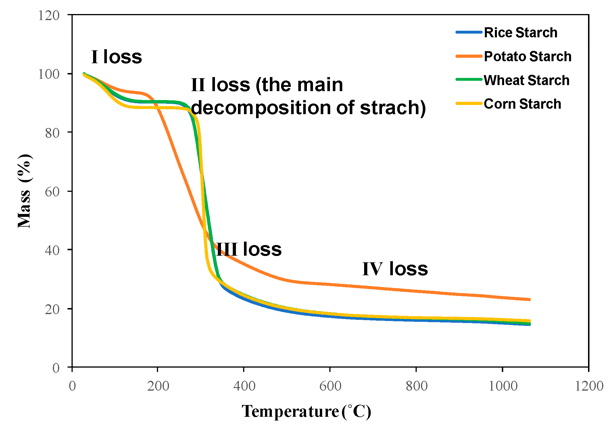It is been reported that amylose molecules are not present as bundles in the amorphous regions within starch granules. They are rather interspersed among amylopectin. The amount of the structures in the starch granule highly depends of its botanical origin. Thermal degradation of starches is the most important issue with their use.
Thermal processing of starch has been largely used in the production of starch-based materials and in food industry. Thermal degradation and stability during processing are important issues from both scientific and industrial perspectives. The unique microstructure of starch and its multiphase transitions during thermal processing provide an excellent model system to illustrate the conceptual approach to investigating the structure–processing–property relationships in most polymers.
The thermal decomposition and stability of starch rely upon its microstructures (such as amylose/amylopectin content and MW), modification and processing conditions.
 Figure 1. Example of thermogravimetric analysis (TGA) comparing native starches [1]
Figure 1. Example of thermogravimetric analysis (TGA) comparing native starches [1]
There have been a variety of techniques used for studying thermal decomposition of starch, such as thermogravimetric analysis (TGA), differential scanning calorimetry (DSC), fourier transform infrared (FTIR) spectroscopy, nuclear magnetic resonance (NMR) spectroscopy, electron paramagnetic resonance (EPR), and mass spectrometry (MS).
TGA has been used widely as a suitable technique to investigate the thermal stability and decomposition of starch & starch-based materials and to determine the content of starch and other components that are generally present in mixtures of starch with artificial polymers. It is a technique that the mass of sample is measured as a function of temperature or time while the sample is subjected to a controlled temperature program in a controlled atmosphere. Dehydration and decomposition have generally been considered as the two major processes associated with the degradation mechanisms of starch in an open system.
The example of the TG analysis is shown is Figure 1. There are four stages of starch decomposition in this study. It is clearly seen that the thermographs of the three native starches (from rice, wheat, and corn) are quite similar, so the rice starch and wheat starch are almost identical and have similar thermal properties. The TGA graph for potato starch seems very different, because of differences in the structure caused by different amounts of polymer compounds and thus the crystalline and amorphous region as well as the granule size.
As one of the leading companies in the omics field with over years of experience in omics study, Creative Proteomics provides glycomics analysis service customized to your needs. Contact us to discuss your project.
How to place an order:

*If your organization requires signing of a confidentiality agreement, please contact us by email.
References
- Marita Pigłowska, Beata Kurc, Łukasz Rymaniak, Piotr Lijewski, Paweł Fuć (2020) Kinetics and Thermodynamics of Thermal Degradation of Different Starches and Estimation the OH Group and H2O Content on the Surface by TG/DTG-DTA. Polymers, 12(2), 357.
- Liu, X., Wang, Y., Yu, L., Tong, Z., Chen, L., Liu, H. and Li, X. (2013) Thermal degradation and stability of starch under different processing conditions. Starch, 65: 48-60.




